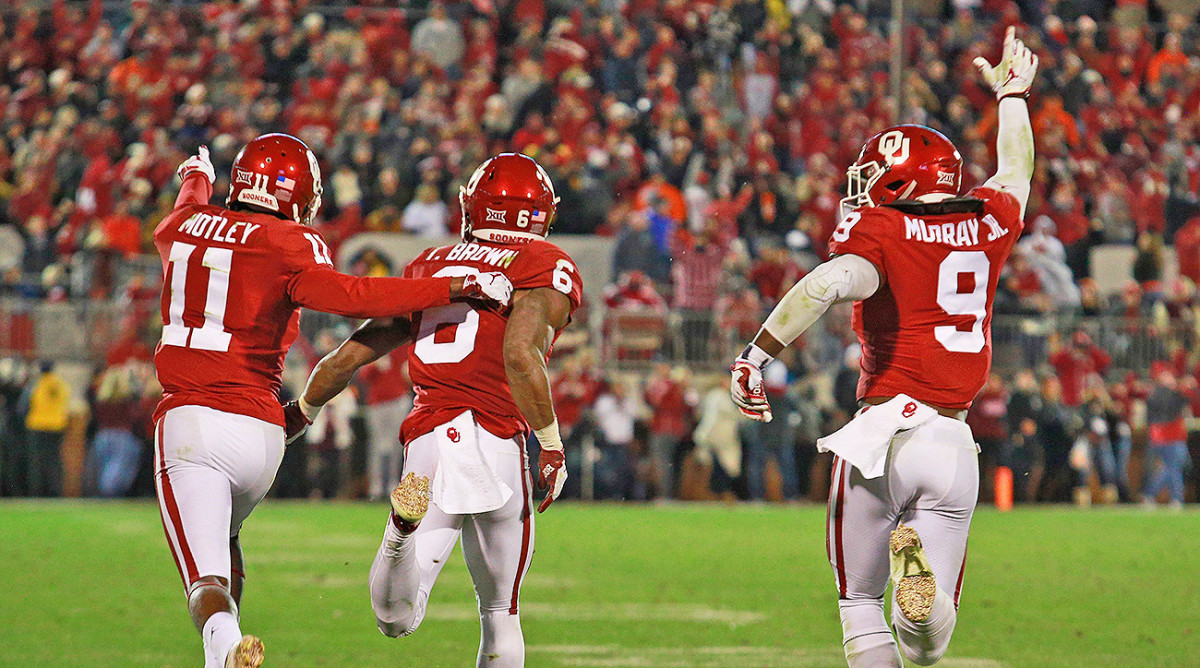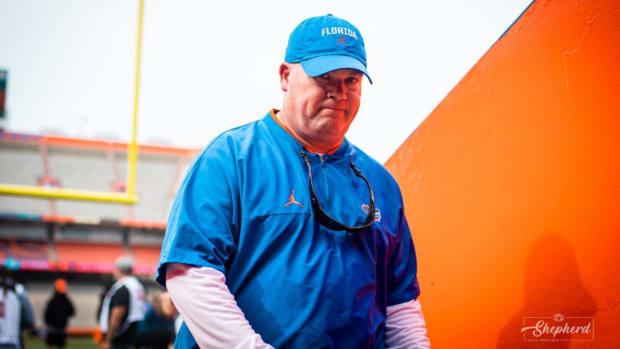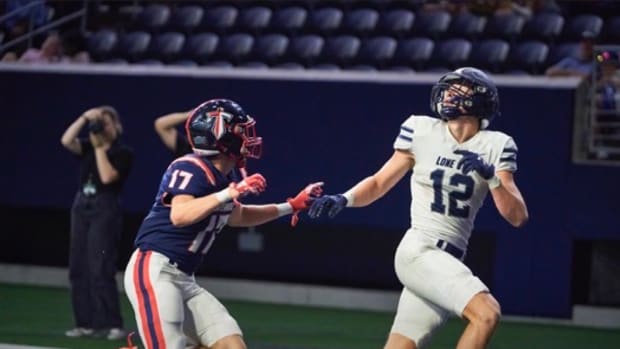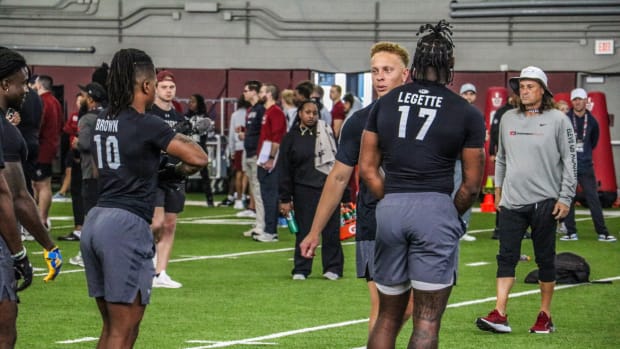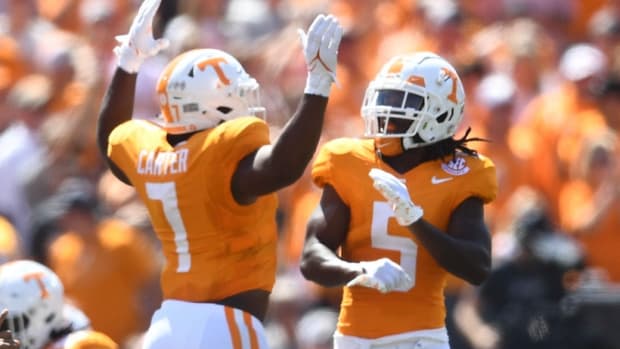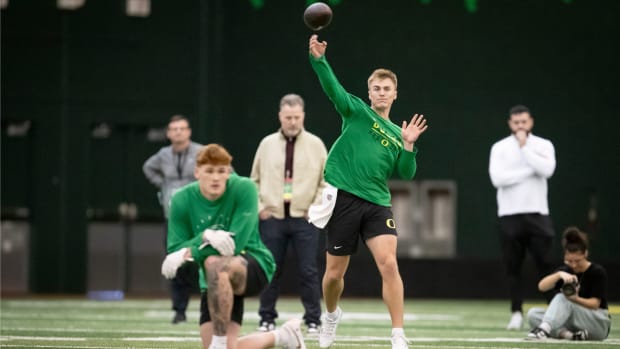Oklahoma Earns Crucial Final Stop to Survive Thrilling Bedlam, Keep Its Playoff Hopes Alive
NORMAN, Okla. — For the second time in as many weeks, a game with Big 12 title implications came down to a two-point conversion attempt by the visiting team at the end of a breakneck shootout. But unlike West Virginia’s successful gamble at Texas last week, Bedlam wouldn’t end with a celebration by the quarterback wearing the white jersey.
Oklahoma State scored on a beautiful 24-yard Taylor Cornelius-to-Tylan Wallace touchdown pass on fourth-and-12 with 62 seconds remaining Saturday, but Oklahoma’s defense—shredded all day and booed at times by its home crowd—stopped the Cowboys when it mattered most, forcing an incomplete pass intended for Wallace in the front right corner of the end zone. The Sooners held on for a 48–47 win that probably gives them little confidence going forward but probably feels incredible nonetheless.
“That’s why they call it Bedlam,” Oklahoma athletic director Joe Castiglione said as he strode onto the field wearing a blue suit and crimson-and-cream fedora. “Every year…”
Last year, it was a 62–52 duel between senior quarterbacks Baker Mayfield and Mason Rudolph that Mayfield’s Sooners won en route to a Heisman Trophy for Mayfield and a berth in the College Football Playoff for the Sooners. This year, the Cowboys came to Norman as 21.5-point underdogs. The quarterback matchup featured Oklahoma State’s Taylor Cornelius, a fifth-year senior who waited his turn behind Rudolph and got his only crack at Bedlam, and Oklahoma’s Kyler Murray, a fourth-year junior who may just surpass Mayfield’s Heisman-season numbers in what could be his only year as Oklahoma’s starter.
RAPAPORT: Ohio State Emerges From Eyesore of a Win With Big Ten Hopes Intact
In their only meeting as starters, Cornelius outdueled Murray but for the last time he threw. Murray continued to operate with ruthless efficiency, completing 21 of 29 passes for 349 yards and a touchdown while also running for 66 yards on 14 carries. But Murray got tremendous help from his offensive line and backs. Kennedy Brooks and Trey Sermon combined to carry 31 times for 289 yards and five touchdowns. Cornelius, meanwhile, completed 34 of 53 passes for 501 yards and three touchdowns. Ten of those completions went to Wallace, who racked up 220 receiving yards and two scores. “We were probably a victim of trying to make them one-dimensional in the throwing game,” Oklahoma coach Lincoln Riley said. The Sooners had decided to try to make Cornelius beat them, and he almost did. “He threw the ball as well as I’ve seen him throw it,” Riley said.
That last throw also was directed at Wallace. But before we examine what went wrong for the Cowboys on a conversion attempt that probably was the correct conceptual call with the incorrect play call, let’s explain how the teams got there.
We’ll start with what happened in Austin last week. West Virginia, trying to ride the momentum of a comeback that led to a 33-yard Will Grier-to-Gary Jennings touchdown pass with 16 seconds remaining, went for two to avoid overtime. Mountaineers coach Dana Holgorsen, who once served as Oklahoma State coach Mike Gundy’s offensive coordinator, made his intention quite clear to anyone who can read lips.
Grier then scored on a naked bootleg, giving the Mountaineers—probably Oklahoma’s chief competition for the Big 12 title—a 42–41 win. Saturday in Norman, Gundy wanted to capitalize on the momentum following the fourth-and-12 backbreaker. But he also had more practical reasons.
The Cowboys took a 35–34 lead midway through the third quarter after Chuba Hubbard ran for a two-yard touchdown. The teams then traded stops before the offenses came alive again.
It looked as if Oklahoma State had stopped the Sooners again when two Cowboys had Oklahoma receiver Marquise Brown surrounded ahead of the sticks on third-and-11 with a little more than a minute remaining in the third quarter. But Brown juked two tacklers and turned the play into a 25-yard gain. Next, Murray escaped the rush and uncorked a 39-yarder to Brown over the middle to set up a five-yard Kennedy Brooks touchdown that allowed Oklahoma to retake the lead as time expired in the third quarter.
Oklahoma State answered immediately, driving 75 yards in 10 plays and finishing with a three-yard Hubbard touchdown run. But just when it seemed the Cowboys would retake the lead, kicker Matt Ammendola hooked the extra point wide left, leaving the score tied at 41.
That miss, combined with a missed 41-yard field goal attempt in the second quarter, made going for two the more reasonable option. And after the dime Cornelius had just thrown, why not give him a chance to win the game with the ball in his hands? Unfortunately, the two-point play the Cowboys ran didn’t give Cornelius or Oklahoma State’s best player many options. Cornelius rolled right, looking at Wallace all the way. Wallace was bracketed by two Oklahoma defenders. Even if Cornelius hadn’t thrown the ball late and behind Wallace, it would have taken a miracle for Wallace to catch the ball. “I don’t know many scenarios where Mike wouldn’t have gone for that,” Riley said. “And if the roles had been reversed, I’d have done the same thing. It was a bold call, and he’s a bold coach.”
Someone asked Gundy if his players were on board with going for two instead of playing for overtime. Judging by their body language on the sideline, the players absolutely agreed with the idea. Not that it mattered. “I’m the only guy that matters on that. I don’t give a [expletive] what they think,” Gundy joked. “They pay me to do that. That way y’all can criticize me.”
BRIEF: Remembering Louisville-Rutgers, 12 Years Later
And it absolutely was the correct call. Argue about the individual play selection all you’d like, but the bold decision was the smart one with a chance to drive a stake into the heart of a rival. “That was a fun game,” Gundy said. “That was a heck of a college football game. We can probably talk about a lot. We made a couple mistakes in the game and they didn’t. So they ended up a point ahead in the end. But I’m very, very proud of our guys.”
Oklahoma remains in control of its Big 12 fate and appears headed for a showdown with West Virginia in Morgantown on Black Friday for control of the league. Depending on what happens with Texas and Iowa State going forward, the Sooners and Mountaineers could wind up meeting again eight days later in the Big 12 title game.
Should the Sooners finish 12–1 and win the Big 12, they’d have a case to make the College Football Playoff. But if they wind up squaring off against a 12–1 Michigan team with a Big Ten title for the No. 4 spot, the selection committee might choose the more balanced Wolverines, who play stellar defense alongside an effective offense. The comparison might be more interesting if the Big Ten champion is a 12–1 Ohio State, because the Buckeyes have had their share of issues on defense this season. But a team that makes an opponent one-dimensional and then gives up more than 500 yards against that dimension—as the Sooners did Saturday—won’t inspire much confidence no matter how explosive its offense. Of course, if the Sooners don’t improve on defense, Grier and the Mountaineers could render moot any argument for Oklahoma’s playoff candidacy. “Every goal that we want is right there in front of us,” Riley said. “And sometimes you’ve got to win when you’re not at your best.”
Also, Oklahoma’s defense did make several critical plays Saturday. With the score tied at 41 and the Cowboys driving, Oklahoma lineman Neville Gallimore forced a Hubbard fumble that Sooners linebacker Kenneth Murray recovered. On the ensuing drive, Brooks gained 49 yards on three carries and Sermon crashed in for a one-yard touchdown that allowed the Sooners to retake the lead. Then, at the end of Oklahoma State’s next drive, the Sooners’ defense got punched in the gut on fourth down and rose to the occasion on the two-point conversion that decided an in-state showdown that wasn’t supposed to be anywhere near that close.
“It lived up to the name,” Oklahoma coach Lincoln Riley said. “It lived up to the rivalry.”
